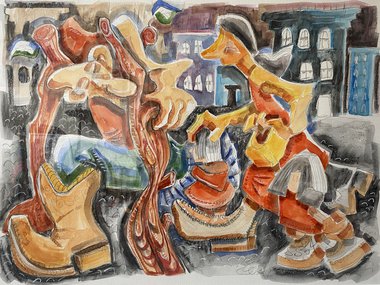Peter Dornauf – 14 October, 2024
When it comes to singular graphite portraits on paper, Shepherd has allowed himself a greater degree of impishness, employing your standard art tropes appropriated from the stables of Picasso as well as the Surrealists. These are studies which in form take the works further away from representation and recall perhaps the practices of Ernst or Masson: part caricature or parody, and going beyond that to a sheer delight in the fanciful and idiosyncratic.
Stuart Shepherd, as part of his work in the field of the arts, has spent a good part of a decade, early this century, promoting other artists’ work, particularly the outsider art variety, often those marginalized by the art world, overlooked and passed over for various reasons. It has taken him to New York City where he has successfully championed the work of a number of self-taught New Zealand artists.
Above and beyond that, his own creative energies have been exercised in a variety of enterprises; for example, being employed as the prop builder for Red Mole, sculptor for Lord of the Rings, as well as the creation of his own kinetic sculpture and installation work. He has also been involved in art teaching roles at Massey, Waikato Wintec and Tauranga Polytech.
Now, for the first time, Shepherd has ventured into the genre of painting, exhibiting his first show at Chris Meek Studio Gallery, in Raglan where he now resides. These paintings, mostly acrylic on paper, focus on narrative, sometimes based on events that actually happened in his residential environs, or being purely creative scenarios conjured out of a fervid imagination, but placed inside a Raglan setting. A third variation comes from events that did take place, but were incidents that occurred in his past, reaching back to the time when he was just a boy.
As he wryly observes, getting up into the high numbers can alter one’s perspective, creating a more rearview take on matters.
These little dramas - a capsized boat, hooking a stingray, an imagined baptism under a bridge — get painted up in a style that floats somewhere between comicbook illustration and expressionist artwork. There is something in Shepherd’s creations that might be recognized in the aesthetic of various comics, along with little hints of things thrown up from a Clairmont palette or Dolezel composition. Their tone is often playful, even whimsical, while the form is characterised by stylization, simplification and calculated exaggeration.
Dramatic contrasting tones are used where red and black predominate. These help provide a unifying minimalist look to the paintings and their overall presentation.
The figures in these works are often twisting and cavorting and are inventively composed, particularly in one work drawn from childhood memory that depicts a boy throwing stones at a bull. Here both the colours and configuration are reminiscent of the early figurative work of Jackson Pollock, particularly his work, Bull’s Head, although Shepherd’s treatment is completely comic in contrast to the American’s overwrought mythical allusions. In Shepherd’s version there is nothing of the tragic journey inside the minotaur’s labyrinth and Pollock’s tormented personal associations. It is simply the artist happily recalling an incident from childhood of teasing an animal - throwing stones at the beast—so it charged a fence in response.
What we get is something in the New Zealand vernacular style that might provoke memories of Murray Ball, but with more compositional inventiveness and more painterly effects.
When it comes to singular graphite portraits on paper, Shepherd has allowed himself a greater degree of impishness, employing your standard art tropes appropriated from the stables of Picasso as well as the Surrealists. These are studies which in form take the works further away from representation and recall perhaps the practices of Ernst or Masson: part caricature or parody, and going beyond that to a sheer delight in the fanciful and idiosyncratic.
It will be interesting to see where Shepherd goes with his painting next, especially if he continues to profitably blend the Picassoesque and Surrealist styles in a kind of marriage.
Peter Dornauf









 Advertising in this column
Advertising in this column Two Rooms presents a program of residencies and projects
Two Rooms presents a program of residencies and projects



This Discussion has 0 comments.
Comment
Participate
Register to Participate.
Sign in
Sign in to an existing account.